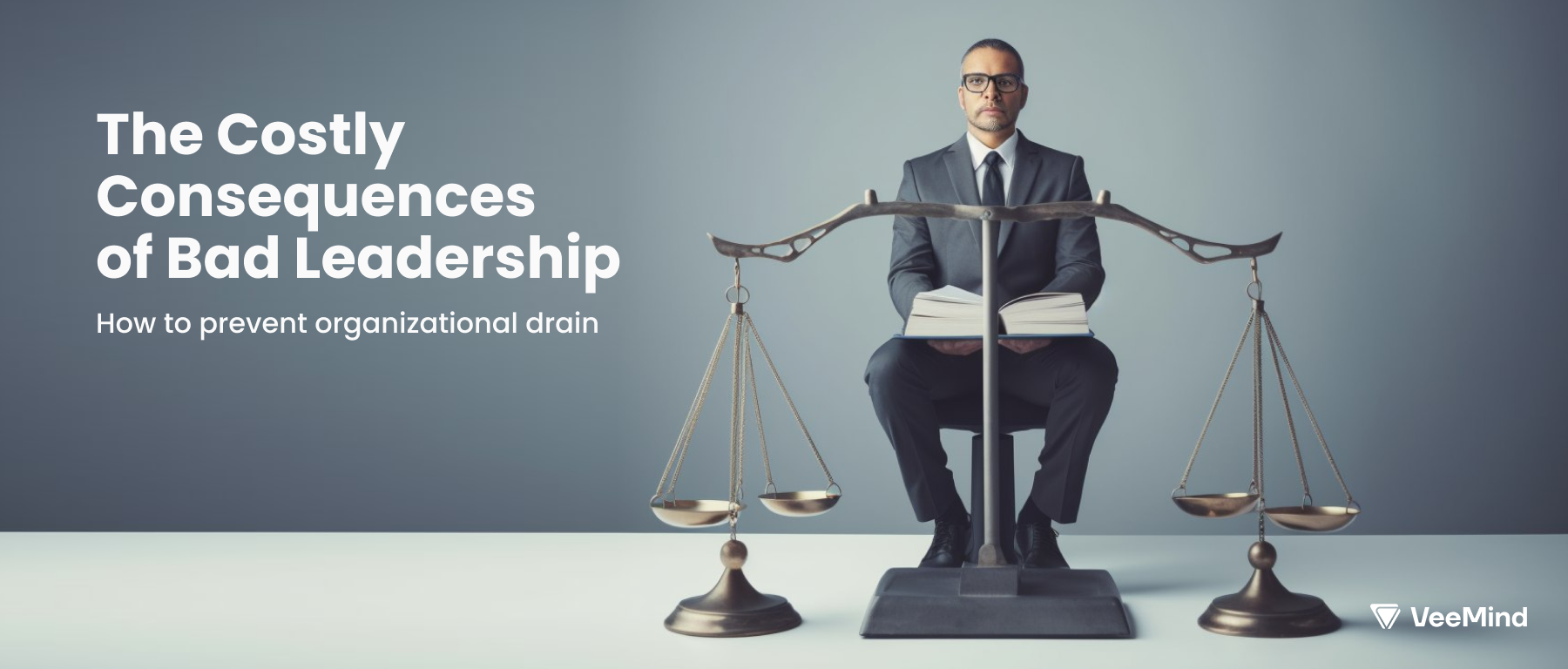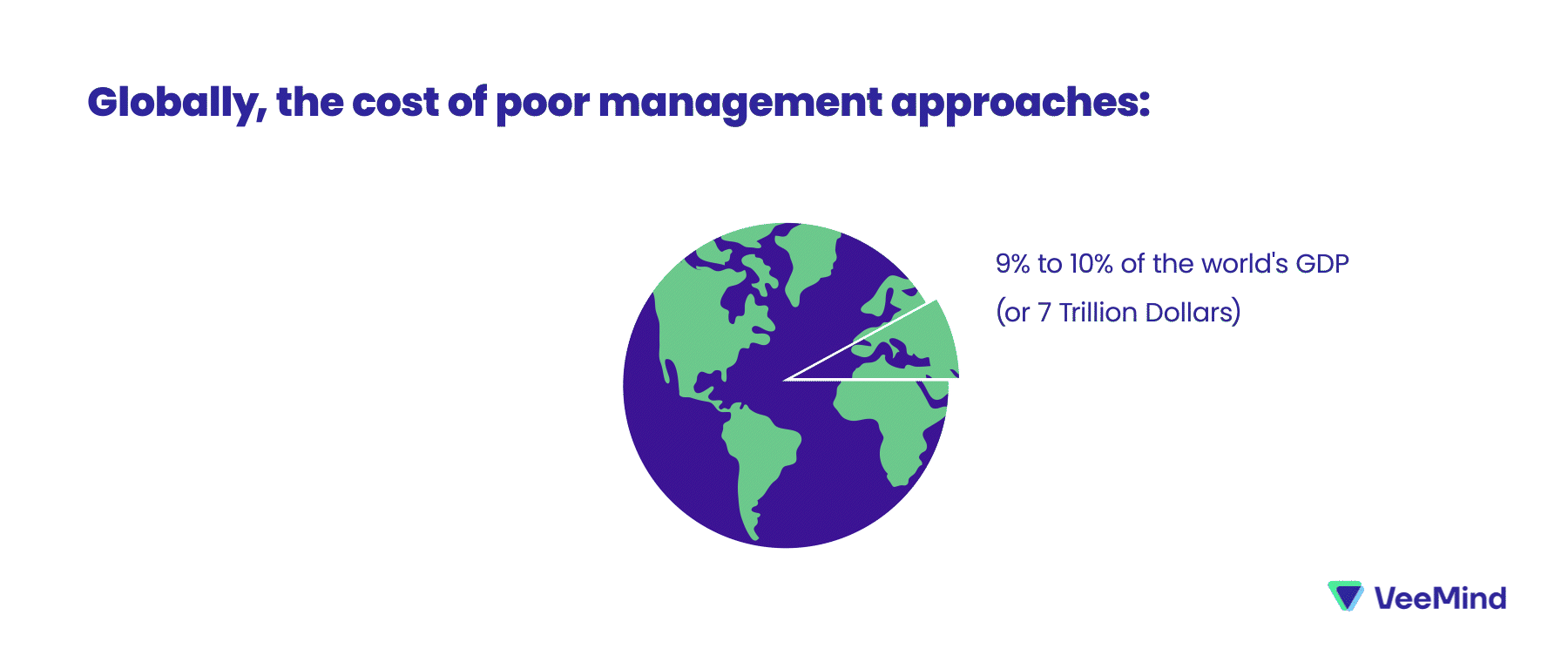The Costly Consequences of Bad Leadership: How to Prevent Organizational Drain

The future’s top workplaces will heavily rely on effective manager development programs, recognizing the substantial financial impact of poor leadership.
In today’s rapidly evolving business landscape, the importance of effective leadership cannot be overstated. However, a concerning reality persists: the cost of poor leadership continues to exact a staggering toll on organizations worldwide. Recent research by Gallup has revealed eye-opening numbers that shed light on the financial implications of inadequate leadership. Globally, the cost of poor management approaches a staggering $7 trillion, accounting for a significant 9% to 10% of the world’s GDP. Within the United States alone, the lack of leadership capability costs corporations up to a mind-boggling $550 billion annually. These figures serve as an urgent wake-up call, demanding organizations to address the issue of bad leadership head-on and take decisive actions to prevent its costly consequences.
„The price of leadership is criticism.“ Albert J. Dunlap
The Gallup research results have brought to light the alarming magnitude of the problem at hand. By delving deep into the dynamics of leadership, Gallup has uncovered the extent of its impact on organizational performance and financial well-being. The findings reveal a distressing truth: poor leadership practices not only hinder productivity and employee engagement but also result in significant financial losses for organizations. It is time for organizations to recognize the critical importance of effective leadership development and implement strategies that cultivate strong and capable leaders at all levels. Failure to do so could mean squandering tremendous economic potential and jeopardizing the future success of the organization.
In this article, we will explore the substantial financial consequences of bad leadership and delve into the root causes behind these costs. We will examine the detrimental effects on productivity, employee turnover, engagement, and innovation. Additionally, we will highlight the urgent need for organizations to invest in comprehensive leadership development programs that focus on individual strengths, empower managers as coaches, and foster a positive leadership culture. By addressing the issue of bad leadership head-on, organizations can mitigate the exorbitant costs and pave the way for a prosperous future, where effective leadership drives success at every level.

When it comes to the costs of bad leadership, there are both tangible and more difficult-to-measure consequences.
While the tangible costs can be quantified, it is the elusive transaction costs that often prove to be larger and more impactful in the long run.
One aspect to consider is the effect of poor leadership on employee retention. While some individuals may choose to quit due to bad leadership, those who decide to stay can potentially cause even greater damage. Disengaged and demoralized employees can have a contagious effect, spreading negativity and dissatisfaction throughout the organization. This not only leads to decreased productivity but also undermines team dynamics and stifles innovation.
„A lousy leader may take a solid team and ruin it, driving the best workers away and demotivating the rest.“
One of the most apparent and measurable costs of bad leadership is the turnover rate or unwanted employee departures. Research indicates that poor leadership is a significant factor contributing to employee turnover.
In one study of 7,272 U.S. adults, Gallup found that 50 percent of employees left their job “to get away from their manager to improve their overall life at some point in their career.”
By creating a toxic work environment or failing to provide adequate support and growth opportunities, leaders can drive talented individuals to seek opportunities elsewhere. Industry averages can provide a baseline for turnover rates, but it is essential to recognize that effective leadership can significantly reduce this rate. Based on experiences, it is reasonable to assume that good leadership practices can cut turnover rates in half, leading to substantial cost savings in recruitment, onboarding, and training.
The cost of attrition
or employee turnover, varies based on individual salaries, but using average figures provides a rough estimate of the overall cost. Yearly turnover rates can be calculated by dividing the number of separations by the average number of employees. Research suggests that replacement costs can range from 50%-60%, with total costs ranging from 90%-200% of an employee’s salary. For instance, replacing an employee earning 30,000€ per year could cost between 15,000€ and 18,000€, resulting in overall losses of approximately 27,000€ to 60,000€ for the company.
In addition to the costs of recruiting, onboarding, and training, there is another significant factor to consider when calculating the costs of unwanted leaves: the cumulative loss of expertise over the years. When experienced employees leave, they take with them valuable knowledge and skills that are difficult to replace. This loss of expertise can have long-term implications for the company’s productivity and competitiveness.
Sick leave
or sickness rates also offer a quantifiable measure of the impact of poor leadership. When employees feel undervalued, unsupported, or overwhelmed due to inadequate leadership, their physical and mental well-being may suffer. By comparing the normal sick leave percentage to the sick leave percentage under poor leadership conditions, one can estimate the associated work loss.
Let’s take an example: Suppose we have a company with 1000 employees, and due to effective leadership, the sick leave rate is reduced by 1%. With an assumption of 200 working days per year, this reduction would amount to approximately 2 days per employee per year.
Now, let’s consider the financial impact. Assuming an annual salary of 60,000 EUR, each sick day costs approximately 300 USD/EUR (60,000 divided by 200 working days). Therefore, the savings per employee would be around 300 USD/EUR per year. When we multiply this by the number of employees (1000), the total savings amount to 300,000 USD/EUR.
A reduction in sick leave by addressing leadership deficiencies can result in increased productivity and decreased costs related to absenteeism.
However, not all costs of bad leadership can be easily quantified in numbers.
Workplace demotivation
is a hidden cost that arises when individuals neither quit nor take sick leave but remain unengaged and stagnant in their work. Frustration and lack of direction under poor leadership can lead to a decline in performance, contributing to wasted time and missed opportunities for growth and innovation.
Prevalence of redundant work
due to poor coordination is another consequence of bad leadership. In an environment where leadership fails to provide clear direction and establish effective communication channels, employees may find themselves duplicating efforts or working on tasks that are ultimately unnecessary. This redundancy wastes valuable resources and hampers productivity.
Lack of clear direction and structure
also results in too many unnecessary meetings, which further add to the cost of bad leadership. Meetings, when not well-organized or focused, consume significant amounts of time and disrupt workflow. Considering the working hours of each meeting participant, the cumulative cost of these unproductive meetings becomes apparent.
In considering the multifaceted costs of bad leadership, it becomes evident that a comprehensive approach is necessary. VeeMind’s six elements of effective leadership— orientation, growth, collaboration, balance, ownership and learning —play a pivotal role in mitigating these costs. By promoting a positive leadership culture that addresses the quantifiable and intangible costs, organizations can foster a productive, engaged, and thriving workforce.
While the quantification of some aspects may require further research and refinement, it is crucial for organizations to recognize the tangible and intangible costs of bad leadership. By investing in leadership development programs and nurturing strong leaders, organizations can reverse the negative impact and create a workplace where employees thrive, costs are reduced, and sustainable success is achieved. It is time for organizations to prioritize the cultivation of effective leadership and embrace the transformative power it holds.
The true cost of bad leadership goes beyond monetary figures
In conclusion, the high costs of bad leadership for organizations are undeniable, both in terms of tangible financial implications and intangible effects on employee morale and productivity. To address this pressing issue, VeeMind offers a powerful solution that can help prevent the negative consequences of bad leadership.
By conducting comprehensive surveys and assessments, VeeMind can analyze the strengths and weaknesses of every manager within an organization. This insightful analysis provides valuable data and insights into each manager’s leadership capabilities and areas for improvement. Armed with this information, organizations can take proactive measures to enhance leadership effectiveness and mitigate the costly impact of poor leadership.
VeeMind offers a solution to mitigate the costs associated with turnovers through its specialized expertise in designing personalized development programs. By focusing on individualized growth and strengths-based development, VeeMind enables managers to enhance their leadership abilities. VeeMind empowers managers to inspire their teams, drive engagement, and cultivate a positive work environment. By investing in the development of managers, organizations can reduce turnover costs and create a more stable and productive workforce.


